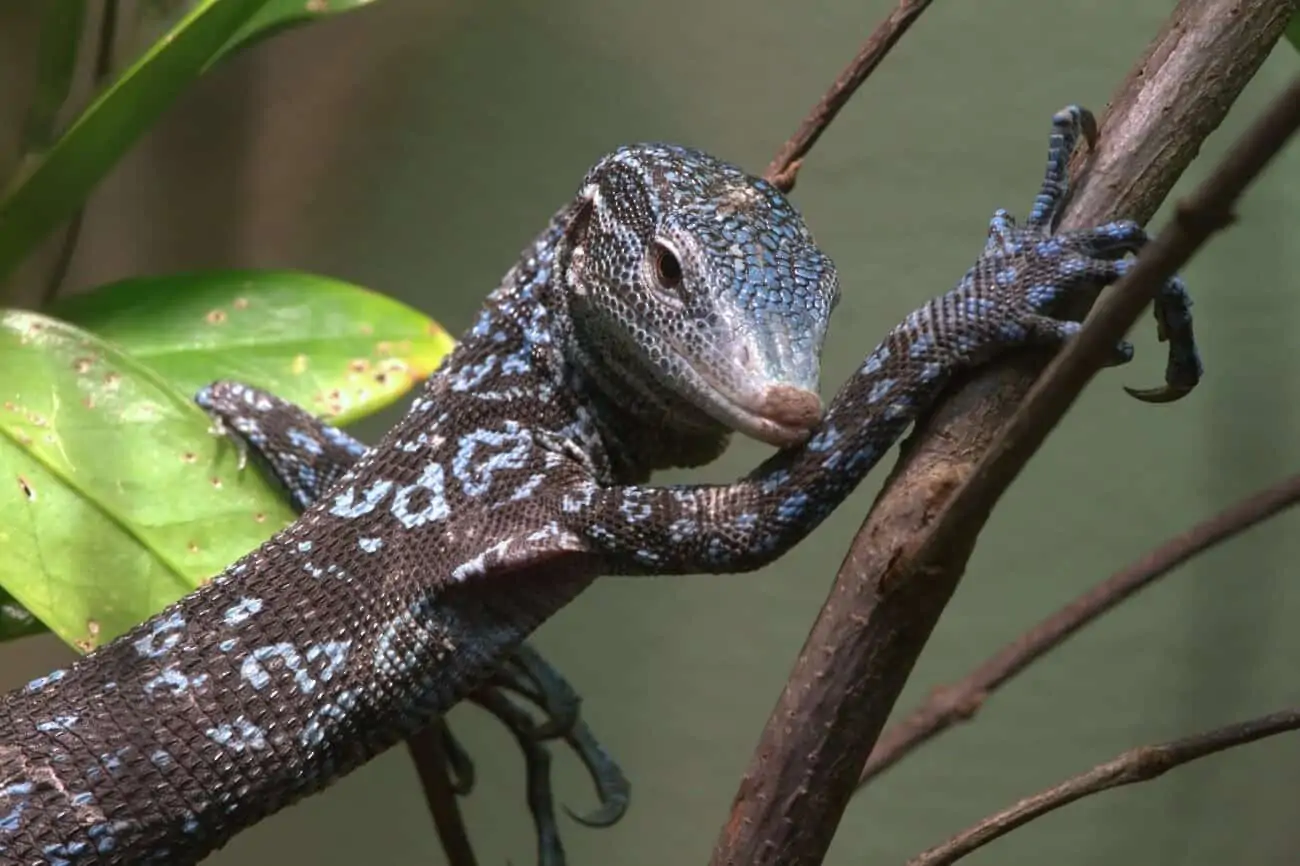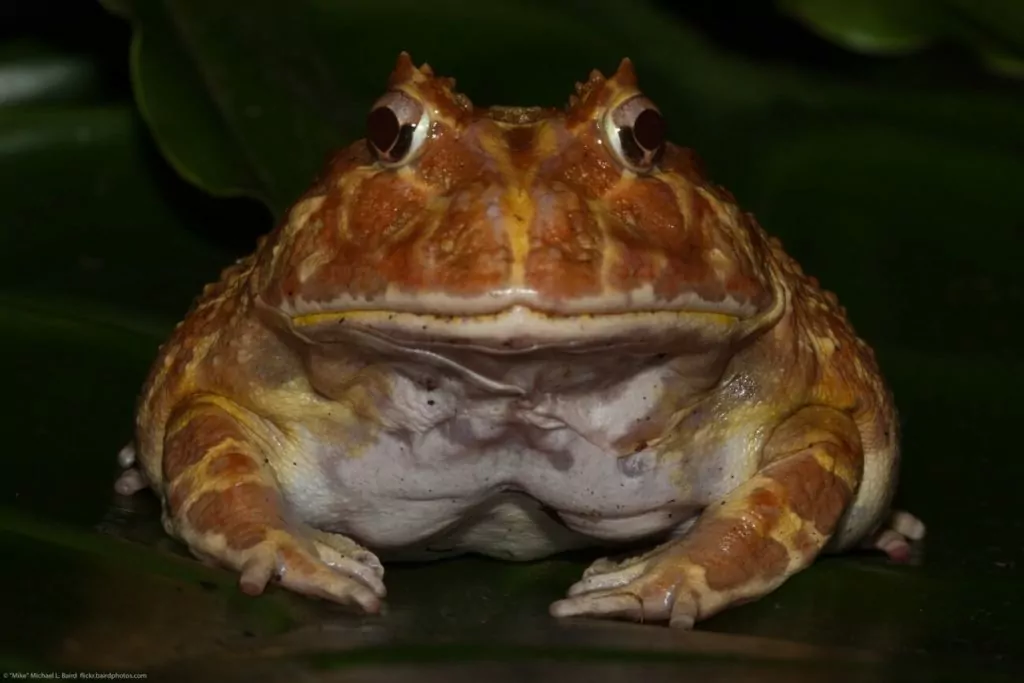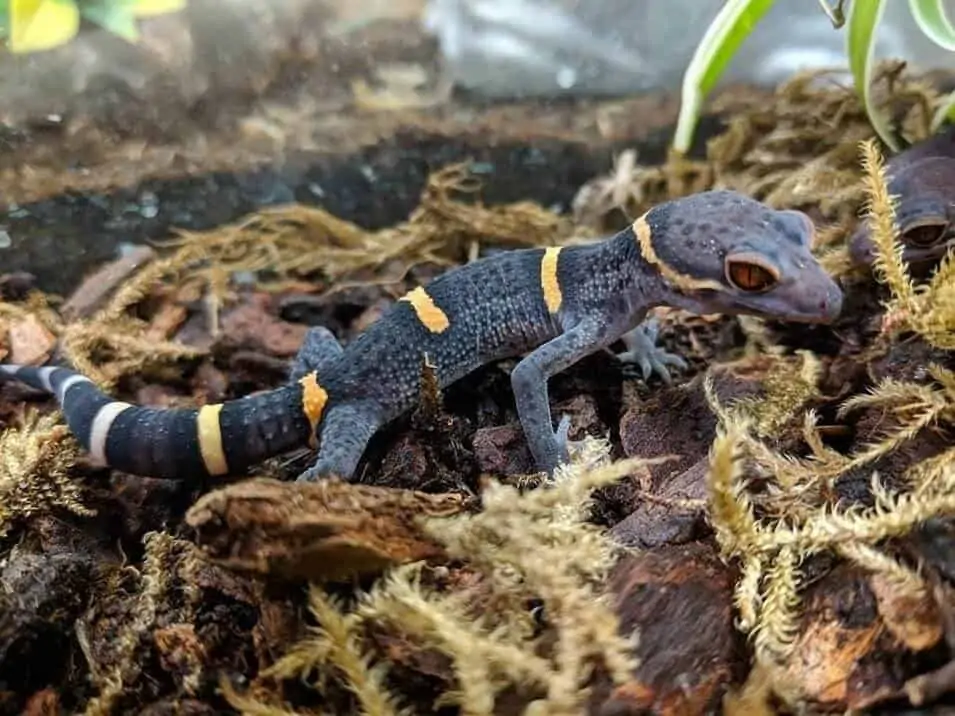Blue tree monitors are a gorgeous reptile that can successfully be kept as pets. In fact, there seems to be a growing level of interest in keeping this species in captivity.
But in order to do it successfully, you need to know what you’re doing. These lizards are not easy to care for, and require a fair bit of experience (and patience).
This guide will go into everything you should know about blue tree monitor care. Not only will it prepare you, but it will also help you decide if you’re up for the challenge!
Table of Contents
Species Summary
The blue tree monitor (Varanus macraei), is an absolutely stunning lizard that is highly coveted by reptile enthusiasts the world over and is native to the tropical environment of Batanta Island, Indonesia. Another common name for this species is the blue-spotted tree monitor.
If you are new to the world of reptile ownership, the blue tree monitor may not be for you. This lizard has very specific requirements and tends to be rather nervous and easily stressed.
The blue tree monitor is usually better suited to owners with intermediate to advanced knowledge of many types of pet lizard care (although that’s not always the case).
Appearance & Colors
What the blue tree monitor lacks in personality, it more than makes up for in appearance. Reptile lovers, from novices to experts, have instantly fallen for the stunning coloration of this monitor.
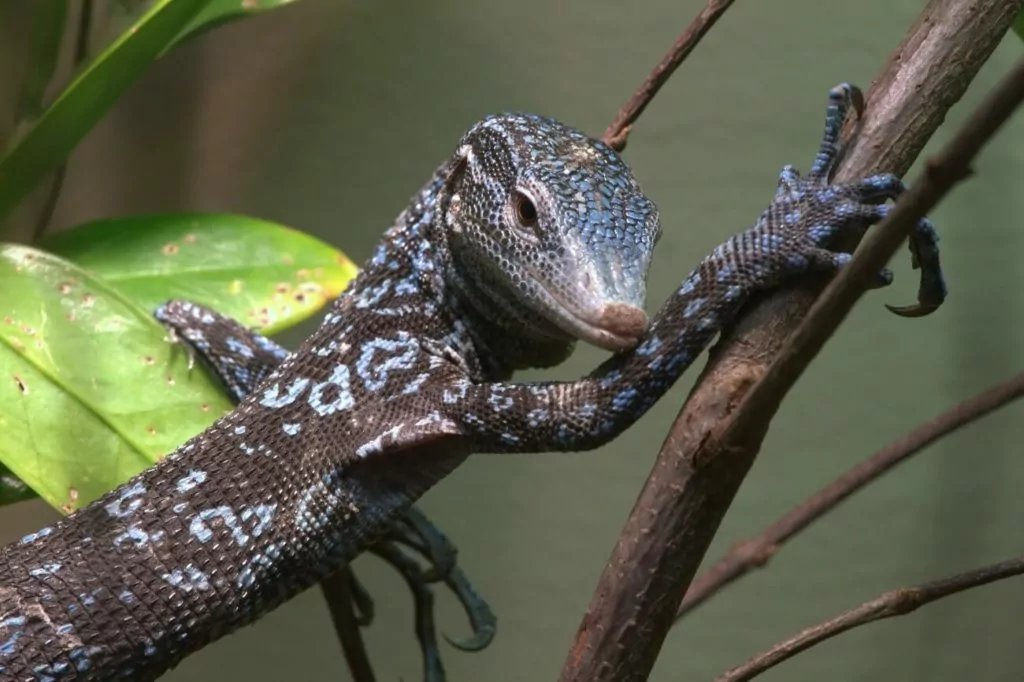
At first glance, you’ll easily see where this reptile gets its name. Upon closer inspection, however, you’ll notice that the body of the blue tree monitor is actually black or dark gray. The belly (sometimes gray and sometimes powder blue) complements the upper body perfectly.
What gives this monitor its one-of-a-kind coloring is actually a series of turquoise-blue ocelli (eye-like spots) that run the length of the body. Smooth-textured nucal (neck) scales flow into a series of keeled (raised ridge) scales that are arranged to form rings.
The body of the monitor is another feature that is highly prized by aficionados. Long, slender limbs, a prehensile tail that is 2/3 of the total body length and five slender digits give this monitor a unique appearance.
Put together, these features produce one of the most striking monitors available. If you’re able to provide them with good care, you’ll be rewarded with quite a beautiful pet to look at!
Average Blue Tree Monitor Size
The average blue tree monitor size is around 42 inches in length for adult males (female monitors tend to be around 4 inches shorter than males).
Expert Tip: This makes the blue tree monitor the largest of the monitors found in the V. prasinus species grouping.
Due to their size, monitors require an above average sized vivarium. Make sure that their minimum enclosure size (more on that later) is compatible with your available living space and ability to care for such a large creature.
Lifespan
With plenty of love, care and species-specific knowledge, blue tree monitors can have a lifespan of ten years or even longer in captivity.
We highly recommend the blue tree monitor for anyone looking for a pet that will bring years of enjoyment and fulfillment. That life expectancy is more than enough time for you to develop a very strong bond!
Blue Tree Monitor Care
Let’s be clear, blue tree monitor care is not a walk in the park. Keeping these lizards as pets requires a lot of effort, which is why we recommend that only owners with some years of experience attempt to keep this particular monitor.
Your blue-spotted tree monitor is going to require plenty of room, proper ventilation, an omnivorous diet and lots of attention and patience.
Its size, nervous demeanor and dietary requirements are all important things to consider before deciding to care for one of these beautiful reptiles.
Enclosure Size & Dimensions
Due to the size of this reptile, a blue tree monitor needs plenty of room. This is an area where there’s a lot of misinformation, so we want to set the record straight.
Some people seem to think that the size of their monitor can be regulated according to the size of the enclosure. A smaller enclosure will not stop your monitor from growing to the average size. Doing this will only cause your pet unnecessary suffering and discomfort.
For young blue tree monitors of six months or younger, an enclosure of about 18″x18″x36″ should be sufficient.
Because adult monitors can grow to be 42 inches long, we recommend an enclosure with minimum dimensions of 4’x2’x4′. If you’re planning to add lots of things to climb and places to hide, this enclosure can and should be larger.
Habitat Setup
Just the same way that you want your own living space to feel cozy and safe, your blue tree monitor will be more comfortable in a habitat setup that’s customized to suit their specific needs.
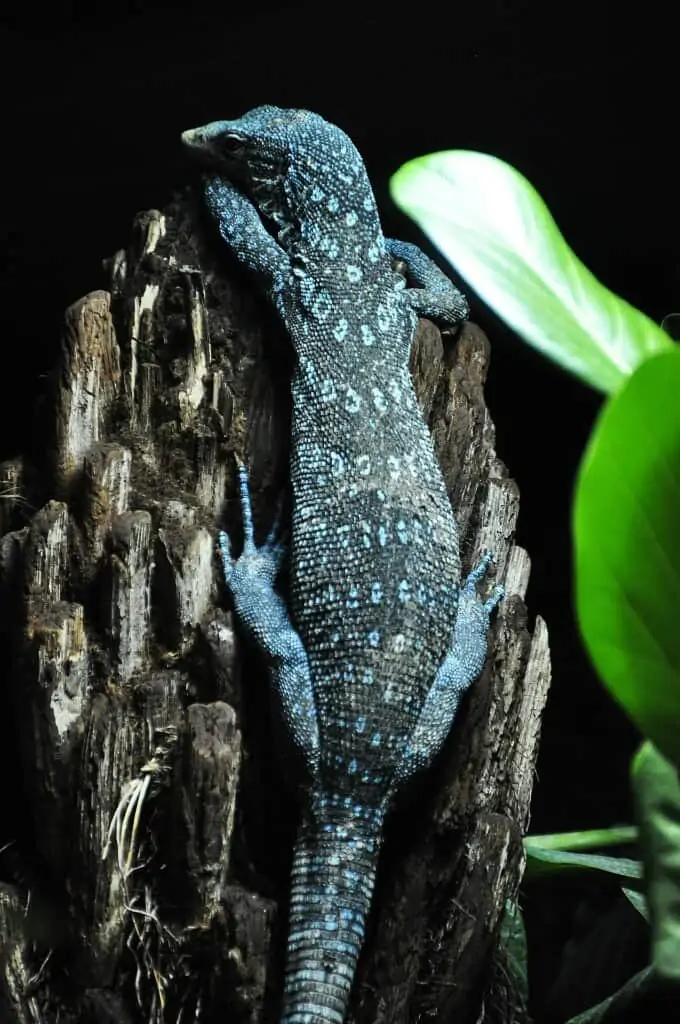
In the wild jungles of Batanta Island, monitor lizards are arboreal creatures. This means that they spend the majority of their time just hanging out in trees.
Due to this aspect of their nature, you will need to provide plenty of items for your monitor to climb. A wide variety of branches and tree trunks are good climbing options.
Blue tree monitor lizards tend to have a nervous disposition, and that’s why they will also require places to hide. Hide boxes or tree trunks will provide the secretive hiding spots monitors crave.
Expert Tip: Make sure that your hiding spots are large enough for the monitor to easily turn around and get comfy. A cramped hiding spot won’t help them at all.
Because blue tree monitors (especially new ones) can freak out and smash themselves into the glass of the enclosure, installing one-way glass or smokey Plexiglass can help them feel safer.
Lastly, it’s very important to add the right substrate to your vivarium. We recommend clean organic soil that is free of chemicals or pesticides. Clean bark chips or a combination of sand and soil work as well.
It’s not recommended to take soil from outside because it can contain parasites or bacteria that can lead to serious health issues for your monitor.
Temperature And Lighting
The temperature and lighting requirements for your blue tree monitor are quite specific, and are critical for the continued health and happiness of your pet.
Once you understand these requirements, setting up and maintaining the atmosphere inside the vivarium becomes a whole lot easier.
The first thing to understand is that your blue tree monitor, like all reptiles, is a cold blooded creature. This means that you will need to provide a temperature gradient inside the enclosure.
Expert Tip: The term temperature gradient basically means that there has to be a warmer basking area and a cooler area for your monitor. This will allow your pet to regulate its body temperature as closely as possible to the way it would in the wild.
With this in mind, we recommend placing heating and lighting fixtures on one side of the vivarium only.
Here are the temperatures to keep in mind:
- The ambient temperature of the vivarium should remain between 83 and 100 degrees Fahrenheit.
- The basking area near the top of the enclosure should be around 104 degrees to 108 degrees Fahrenheit.
- A night time temperature of as low as 78 degrees is acceptable.
Never use heating rocks to provide heating. In the wild, a blue tree monitor gets heat from above, so heating rocks won’t provide any benefit.
As for lighting, it’s important to provide your blue tree monitor with plenty of UVB light. Failing to do this will result in serious health complications.
This is because in captivity, your lizard does not get the full amount of sunlight it needs. A UVB source, such as a fluorescent lamp, will provide the light necessary to help absorb calcium and create Vitamin D3.
A mercury vapor light bulb will conveniently provide both heat and UVB, but you can certainly use separate heating and lighting elements if it works better for your setup. The best UVB light bulb to use is a 100 watt bulb.
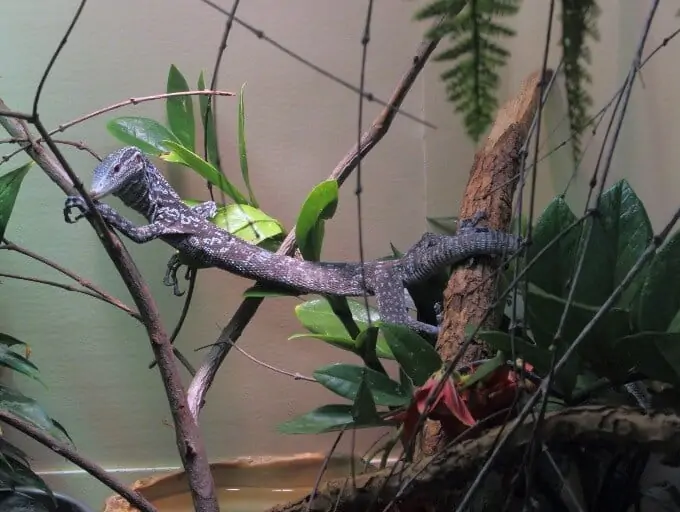
The last point to take into consideration is that the basking area can get direct light from a heat lamp, but the rest of the lighting in the vivarium should be indirect light. Using plenty of leafy cover will help mimic the indirect natural light of their habitat.
Lighting in the vivarium should be on for 10-13 hours each day. This should be a fairly easy schedule to follow (and can be automated with timers).
Humidity
Make sure to keep humidity levels at about 80 percent inside the enclosure. Misting the enclosure a few times a day will be fine, but some monitor owners prefer to use an automatic mister for the sake of convenience.
In order to keep an eye on the humidity of your vivarium atmosphere, humidity gauges (aka hygrometers) are an investment we highly recommend.
Water
Your blue tree monitor needs a constant supply of fresh, clean water. Since these lizards will only drink from a standing water source, we suggest putting the water in a large bowl. This bowl needs to be big enough for drinking and bathing.
Expert Tip: Change the water at least once per day, and clean the bowl thoroughly once a week. This will help keep disease at bay and keep your pet comfortable.
Food And Diet
Feeding your blue tree monitor is not as complicated as you might think. Crickets, grasshoppers, roaches and other large insects that have been dusted with calcium and phosphorus powder will make these smart lizards very happy.
However, before you give them their insects, let them have some type of green vegetables such as celery, lettuce, or spinach. These greens add vitamins and bulk to your monitor’s diet.
Freshly killed mice (although not native to their diet) can be given twice a week for added nutrition.
Always remember to clean away any uneaten food from the enclosure. Do this daily to keep their enclosure a safe and healthy place to live.
Potential Health Issues
Being a responsible pet owner means that you should have a working knowledge of the potential health issues that can arise. The following is a partial list of some of the more common monitor issues.
Issue 1: Blue tree monitors (and monitors in general) are very susceptible to infections from molds and fungus. If you see a spot that looks like a bruise or burn, it could very well be the beginning of a fungal infection. Take your lizard to the vet right away for a diagnosis.
Issue 2: If your monitor is stressed, or if the conditions of the enclosure are not ideal, then your pet is far more likely to develop a respiratory infection.
Issue 3: Parasites, like worms or protozoa, can really plague this species. Regular vet visits can help to spot a parasite problem before it gets out of hand.
Issue 4: Your monitor can get sick quickly if the humidity and temperature are not kept at ideal levels. Using a hygrometer and a thermometer are very important. Having proper ventilation in the vivarium will help to regulate both temperature and humidity.
Behavior & Temperament
Blue tree monitors are diurnal creatures which means that they are most active during the day. You’ll probably see these reptiles basking for part of the day and “hunting” (or just relaxing in the shade) for the other portion.
Monitors tend to be nervous animals that don’t like to be handled excessively. They don’t bite often, but they will if they are stressed or scared.
Handling Them
As we hinted at above, blue tree monitors do not like to be handled. If you insist on handling them (and have skill and patience) they can be trained to tolerate some gentle handling.
An important point to remember is that heavy gloves and long sleeves should always be worn when you handle your blue tree monitor. They have sharp claws and teeth, and they will scratch or bite if scared.
While some people have had success training and handling these reptiles, we think that their temperaments should be respected. You can get just as much enjoyment by spending time observing their interesting and unique behaviors.
Giving them the space to do what blue tree monitors do best, is the key to a happy relationship with this particular pet.
Conclusion
As you can tell, blue tree monitor care is something we only recommend to experienced owners. While beautiful, the size and temperament of these reptiles makes them quite finicky in captivity.
If you think you’re up for the challenge and want to get started, we say go for it! These lizards are absolutely stunning, and owning one is something that not many people have done.
The bond you’ll develop and the rewarding nature of the experience will definitely be worth the effort.

